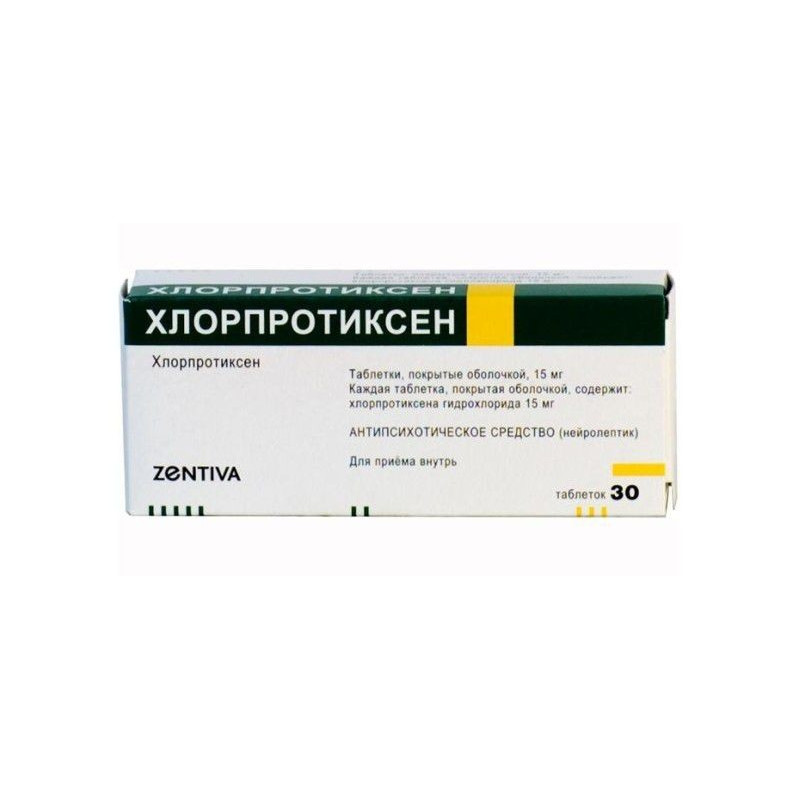



 All payments are encrypted via SSL
All payments are encrypted via SSL
 Full Refund if you haven't received your order
Full Refund if you haven't received your order
Chlorprothixene Zentiva is a sedative neuroleptic with a wide range of indications, which include:
- psychosis, including schizophrenia and manic states, occurring with psychomotor agitation, agitation and anxiety;
- "hangover" withdrawal syndrome in alcoholism and drug addiction;
- hyperactivity, irritability, agitation, confusion in elderly patients;
- behavioral disorders in children;
- depression, neurosis, psychosomatic disorders;
- insomnia;
- pain (in combination with analgesics).
Psychoses, including schizophrenia and manic states.
Treatment begins with 50-100 mg / day, gradually increasing the dose to achieve the optimal effect, usually up to 300 mg / day. In some cases, the dose may be increased to 1200 mg / day. Maintenance dose is usually 100-200 mg / day. The daily dose of Chlorprothixene Zentiva is usually divided into 2-3 doses, given the pronounced sedative effect of Chlorprothixene Zentiva, it is recommended to prescribe a smaller part of the daily dose in the daytime, and a large part in the evening.
Hungover withdrawal syndrome in alcoholism and drug addiction.
The daily dose, divided into 2-3 doses, is 500 mg. The course of treatment usually lasts 7 days. After disappearance of withdrawal symptoms, the dose is gradually reduced. Maintenance dose of 15-45 mg / day helps stabilize the condition, reduces the risk of developing the next binge.
In elderly patients in the presence of hyperactivity, irritability, excitement, confusion, 15-90 mg / day is prescribed. The daily dose is usually divided into 3 doses.
In children for the correction of behavioral disorders, Chlorprothixene Zentiva is prescribed at the rate of 0.5–2 mg / kg body weight.
Depression, neurosis, psychosomatic frustration.
Chlorprothixene Zentiva can be used for depression, especially when combined with anxiety, stress, as an adjunct to antidepressant therapy or independently. Chlorprothixene Zentiva can be prescribed for neurosis and psychosomatic disorders, accompanied by anxiety and depressive disorders up to 90 mg / day. The daily dose, as a rule, is divided into 2-3 doses.Since taking Chlorprothixene Zentiva does not cause the development of addiction or drug dependence, it can be used for a long time.
Insomnia. At 15 - 30 mg in the evening for 1 hour before bedtime.
Pains. The ability of Chlorprothixene Zentiva to potentiate the action of analgesics can be used in the treatment of patients with pain. In these cases, Chlorprothixene Zentiva is prescribed together with analgesics in doses of 15 to 300 mg.
Drowsiness, tachycardia, dry mouth, excessive sweating, difficulty of accommodation. These side effects, usually occurring at the beginning of therapy, often disappear as it continues.
Orthostatic hypotension may occur, especially with Chlorprothixene Zentiva in high dosages.
Dizziness, dysmenorrhea, skin rashes, constipation are rare. Extrapyramidal symptoms are especially rare.
Described isolated cases of decrease in seizure threshold, the occurrence of transient benign leukopenia and hemolytic anemia.
With prolonged use, especially in high doses, there may be: cholestatic jaundice, galactorrhea, gynecomastia, decrease in potency and / or libido, increased appetite, increase in body weight.
- inhibition of the central nervous system of any origin (including caused by alcohol, barbiturates or opiates);
- coma;
- vascular collapse;
- diseases of the blood;
- pheochromocytoma;
- hypersensitivity to the drug.
Use during pregnancy and lactation
If possible, Chlorprothixene Zentiva should not be given to pregnant women during breastfeeding.
Application for violations of the liver
Chlorprothixene Zentiva should be used with caution in patients with marked impairment of liver function.
Application for violations of kidney function
Chlorprothixene Zentiva should be used with caution in cases of marked renal impairment.
In children for the correction of behavioral disorders, Chlorprothixene Zentiva is prescribed at the rate of 0.5–2 mg / kg body weight.
Use in elderly patients
In elderly patients in the presence of hyperactivity, irritability, excitement, confusion, 15-90 mg / day is prescribed.The daily dose is usually divided into 3 doses.
Chlorprothixene Zentiva should be used with caution in patients suffering from epilepsy, parkinsonism, in severe cerebral atherosclerosis, with a tendency to collapse, in severe cardiovascular and respiratory failure, in severe impaired function of the liver and kidney, diabetes, prostatic hypertrophy.
The use of Chlorprothixene Zentiva can lead to a false positive result when carrying out an immunobiological test of urine for pregnancy, a false increase in the level of bilirubin in the blood, a change in the QT interval on an electrocardiogram.
During drug treatment, it is recommended to refrain from the use of alcoholic beverages, to avoid increased insolation.
Influence on ability to drive motor transport and control mechanisms
The intake of Chlorprothixene Zentiva has a negative impact on activities that require a high rate of mental and physical reactions (for example, driving, maintaining cars, working at height, etc.).
Symptoms Drowsiness, hypo-or hyperthermia, extrapyramidal symptoms, convulsions, shock, coma.
Treatment. Symptomatic and supportive. Gastric lavage should be performed as soon as possible, the use of a sorbent is recommended. Measures should be taken to support the activity of the respiratory and cardiovascular systems. Do not use adrenaline, because this can lead to a subsequent lowering of blood pressure. Spasms can be stopped by diazepam, and extrapyramidal disorders biperidenom.
The inhibitory effect of Chlorprothixene on the CNS may be enhanced while taking with ethanol and ethanol-containing drugs, anesthetics, opioid analgesics, sedatives, hypnotics, antipsychotics.
The anticholinergic effect of Chlorprothixene is enhanced with simultaneous use of anticholinergic, antihistamine and anti-Parkinsonian drugs.
The drug enhances the action of antihypertensive drugs.
The simultaneous use of Chlorprothixene and adrenaline can lead to arterial hypotension and tachycardia.
The use of Chlorprothixene reduces the threshold of seizure activity, which requires an additional dose adjustment of antiepileptic drugs in patients with epilepsy.
The ability of Chlorprothixene to block dopamine receptors reduces the effectiveness of levodopa.
Extrapyramidal disorders may occur with simultaneous use of phenothiazines, Metoclopramide, Haloperidol, reserpine.
Terms and conditions of storage
List B. Store at a temperature of 10-25 ° C, in a dry place inaccessible to children.
